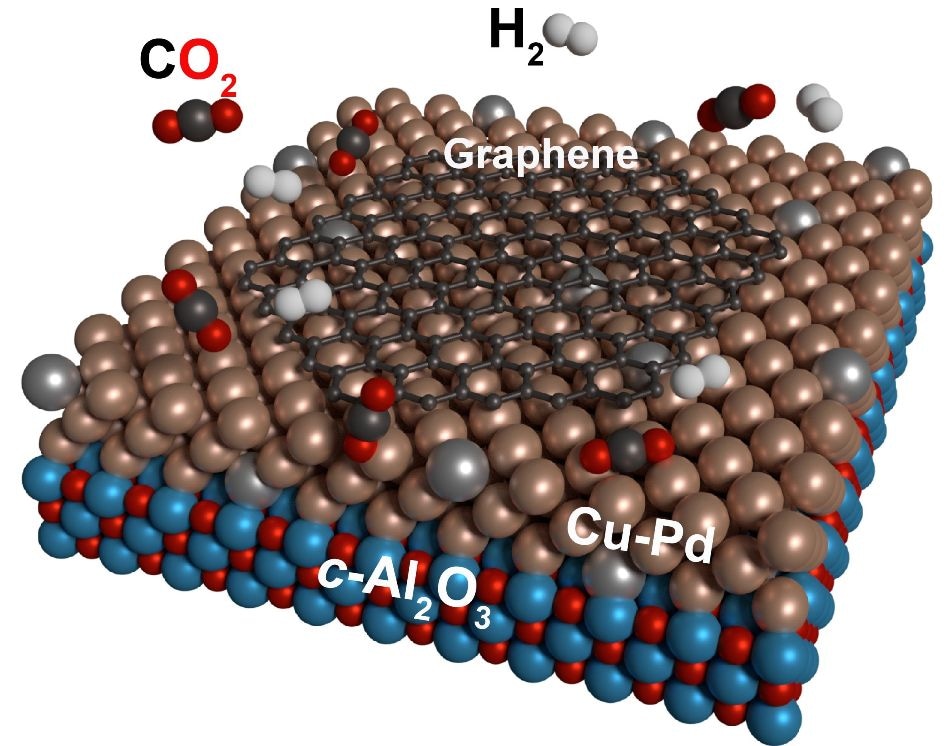Jul 10 2019
Most people are aware that the chemical compound carbon dioxide is a greenhouse gas in the atmosphere and that it has a global-warming effect.
 Carbon dioxide (red-black) and hydrogen (gray) catalytically react to graphene (black) on copper-palladium surfaces. (Image credit: E. Moreno-Pineda, KIT)
Carbon dioxide (red-black) and hydrogen (gray) catalytically react to graphene (black) on copper-palladium surfaces. (Image credit: E. Moreno-Pineda, KIT)
However, carbon dioxide can also be a valuable raw material for chemical reactions. A working group from Karlsruhe Institute of Technology (KIT) has currently described this unusual application in the ChemSusChem journal. They are using carbon dioxide as a raw material to manufacture graphene, a technological material which is presently the topic of powerful research.
The combustion of fossil fuels like coal and oil generates energy for heat, electricity, and mobility; however, it also results in an increase in the amount of carbon dioxide in the atmosphere, thus leading to global warming.
Breaking this causal chain inspired researchers to look for alternative energy sources and also for alternative uses of carbon dioxide. One possibility could be to view carbon dioxide as an economical raw material for the manufacture of costly materials, feeding it back into the reusability cycle — maybe even in a profitable manner.
An example of this can be observed in nature. When photosynthesis occurs in the leaves of plants, the blend of water, light, and carbon dioxide produces biomass, sealing the natural material cycle. In this process, it is the work of the metal-based enzyme RuBisCo to take up carbon dioxide from the air and turn it useful for additional chemical reactions in the plant.
Motivated by this metal enzyme-based natural conversion, scientists at KIT have now come up with a process in which the greenhouse gas carbon dioxide along with hydrogen gas is transformed directly into graphene at temperatures of up to 1000 ○C using uniquely prepared, catalytically active metal surfaces.
Graphene is the 2D form of the chemical element carbon, which has exciting electrical properties and is hence an alternative for innovative future electronic components. Its invention and workability in 2004 resulted in universal, rigorous research and obtained the Nobel Prize for Physics in 2010 for the discoverers Andre Geim and Konstantin Novoselov. The duo manually eliminated the graphene from a block of graphite with the help of tape.
Many working groups from KIT have partnered to exhibit a technique in the ChemSusChem journal for isolating graphene from carbon dioxide and hydrogen using a metal catalyst.
If the metal surface exhibits the correct ratio of copper and palladium, the conversion of carbon dioxide to graphene will take place directly in a simple one-step process.
Professor Mario Ruben, Head of the Study, Molekulare Materialien working group, Institute of Nanotechnology (INT) and Institute for Inorganic Chemistry (AOC), KIT
In subsequent experiments, the scientists were even able to develop graphene with a thickness of several layers, which could be fascinating for potential applications in electronic components, batteries, or filter materials.
The next research objective of the working group is to create operational electronic components from the resultant graphene. Carbon materials like graphene and magnetic molecules could be the building blocks for future quantum computers, which allow energy-efficient and ultra-fast estimations but are not based on the binary logic of present computers.